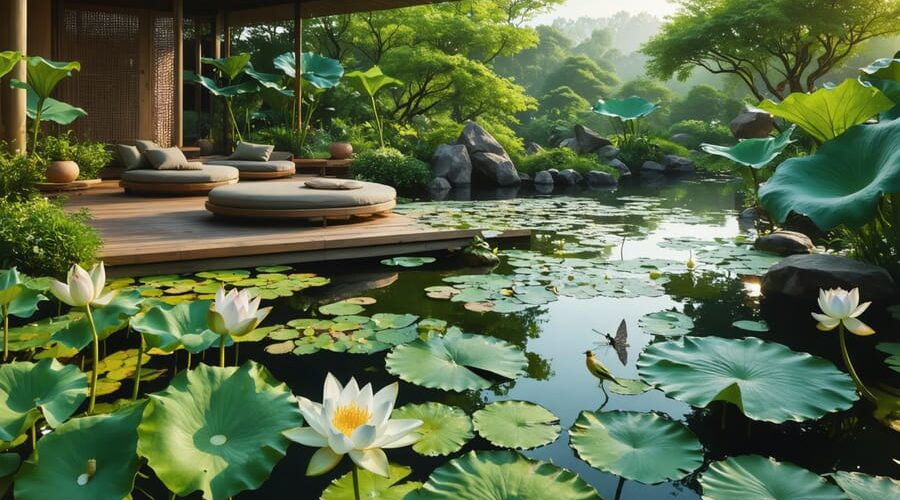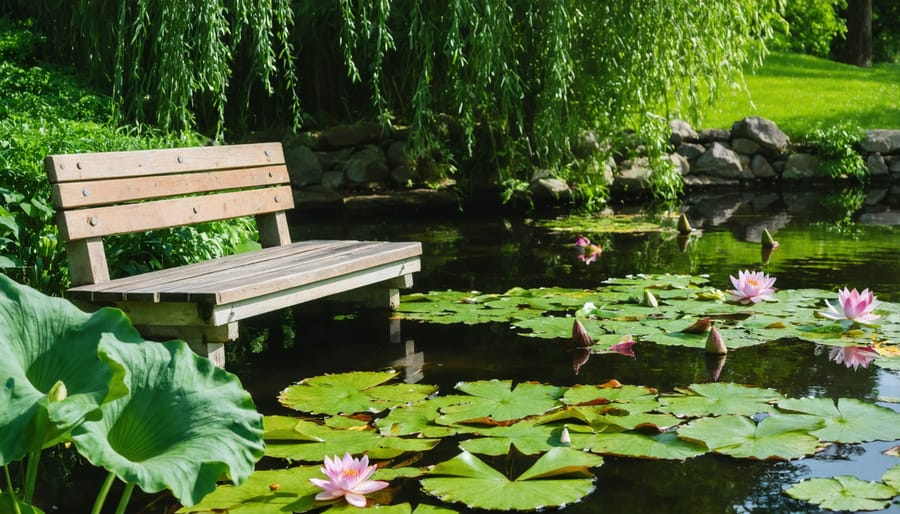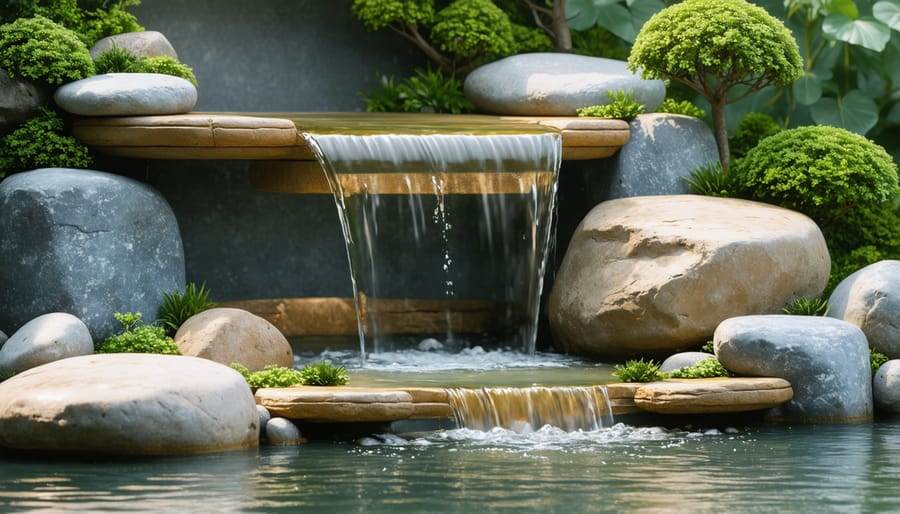
Transform Your Pond into a Serene Meditation Haven
Transform your backyard pond into a serene meditation sanctuary by positioning comfortable seating on stable ground within arm’s reach of gently moving water. The natural rhythm of flowing water, combined with the open sky above, creates an unmatched environment for mindfulness practice that indoor spaces simply can’t replicate.
Create layers of calming sensory experiences by incorporating aquatic plants like water lilies and lotus, which not only provide visual beauty but also attract melodious birds and graceful dragonflies. The subtle interplay of natural elements – from the whisper of cattails in the breeze to the sparkle of sunlight on rippling water – naturally guides your mind toward tranquility.
Start with just five minutes at dawn or dusk, when the world transitions and wildlife is most active. Let the natural sounds of your water feature anchor your attention while the outdoor setting helps dissolve the mental clutter that often plagues indoor meditation attempts. This combination of water, wildlife, and open air creates an ideal space for both beginners and experienced practitioners to deepen their meditation practice.
Why Your Pond is the Perfect Meditation Spot
The Science Behind Water and Relaxation
Scientific research has shown that being near water has a profound effect on our mental well-being. The gentle sound of flowing water produces negative ions, which are known to reduce stress hormones and increase serotonin levels in our brains. When we meditate near water, these natural elements work together to create what marine biologists call a “blue mind” state – a calm, peaceful mental condition that’s perfect for meditation.
Studies from the University of Exeter have found that people who spend time near water report higher levels of relaxation and lower anxiety levels. The rhythmic sounds of water, whether from a small pond fountain or a gentle waterfall, match the frequency of our brain waves during meditation, making it easier to achieve a deeper meditative state.
Additionally, the reflective surface of water helps focus our attention, naturally drawing our eyes and minds to the present moment – a fundamental aspect of successful meditation practice.
Natural Sound Therapy
The gentle sounds of moving water have been used for centuries to enhance meditation practices, creating a natural symphony that helps calm the mind and deepen relaxation. Whether it’s the soft rippling of a stream, the steady flow of a waterfall, or the peaceful splashing of fountain jets, water sounds provide a consistent, soothing background that helps mask distracting noises and creates an ideal environment for mindfulness.
Water features in your meditation space can serve as both visual and auditory anchors. The consistent sound patterns help regulate breathing and provide a focal point for concentration. Studies have shown that natural water sounds can lower cortisol levels and reduce stress, making them particularly effective for meditation practices.
To maximize these benefits, position your meditation spot where you can clearly hear the water without it being overwhelming. The sound should be gentle enough to blend with the natural environment while still maintaining its calming presence. Consider adjusting your water feature’s flow rate to find the perfect balance for your practice.
Creating Your Pond Meditation Space
Choosing the Perfect Spot
When selecting your outdoor meditation spot near your pond, look for a relatively flat, comfortable surface where you can sit undisturbed. Consider the amount of sunlight throughout the day – morning or late afternoon light is often ideal, while direct midday sun might be too intense. Choose a location that offers some shelter from strong winds but still allows you to feel the gentle breeze.
Your chosen spot should provide a clear view of your pond and water features, allowing you to incorporate the soothing sounds of flowing water into your practice. If possible, position yourself where you can see aquatic plants or fish, as these natural elements can enhance your meditation experience.
Privacy is another crucial factor. While complete isolation isn’t necessary, you’ll want enough separation from high-traffic areas to maintain focus. Consider using tall plants, decorative screens, or natural barriers to create a more secluded atmosphere.
The ground surface matters too. A flat paving stone, wooden deck, or sturdy garden bench can provide stable seating. For added comfort, keep a weather-resistant cushion nearby for your meditation sessions.

Essential Comfort Elements
Creating a comfortable seating arrangement is essential for successful outdoor meditation by your pond. Start with a dedicated meditation cushion or bench that’s weather-resistant and easily portable. Memory foam cushions with waterproof covers work wonderfully, while teak or cedar benches offer natural beauty and durability. Position your seating on a level surface, ideally on a small platform or paver stones to prevent direct ground contact.
Shade protection is crucial for longer meditation sessions. Consider installing a retractable awning or umbrella that you can adjust based on the sun’s position. Natural shade from trees works beautifully, but ensure any overhanging branches won’t drop debris into your pond. A portable pop-up canopy offers flexibility and can be stored when not in use.
Weather protection goes beyond shade. Keep a waterproof storage box nearby for meditation supplies and cushions. Choose a location that offers some wind protection, perhaps near tall plants or a decorative screen. For chilly mornings, keep a few outdoor blankets handy – wool or fleece blankets with waterproof backing are ideal.
Consider seasonal comfort too. In summer, position a small battery-operated fan nearby and keep insect repellent accessible. For cooler months, outdoor heating options like infrared heaters can extend your meditation season. Adding weather-resistant side panels to your shade structure creates a cozy meditation nook while maintaining your connection to the pond environment.
Remember to keep your comfort items organized and easily accessible. A small weatherproof storage cabinet or deck box placed strategically near your meditation spot ensures everything you need is within reach without disrupting the area’s peaceful atmosphere.
Enhancing Your Pond for Meditation
Peaceful Plant Selection
Creating a serene meditation space starts with choosing the right plants to complement your water feature. The best aquatic plants like water lilies and lotus flowers naturally create a peaceful atmosphere, but don’t forget about the surrounding garden area.
Consider adding lavender for its calming scent and gentle movement in the breeze. Japanese maples offer elegant shapes and seasonal color changes that encourage mindful observation. Bamboo creates a natural privacy screen while producing soothing rustling sounds that enhance meditation.
For ground cover, try creeping thyme or moss, which release gentle fragrances when stepped upon and create soft pathways. Ornamental grasses like fountain grass or Japanese forest grass add flowing movement that helps quiet the mind.
Near your seating area, plant aromatherapeutic herbs such as sage, rosemary, and lemon balm. These plants not only engage your senses but also attract butterflies and birds, adding natural entertainment to your meditation space.
Remember to choose low-maintenance varieties that won’t disturb your peace with constant care needs. Group plants with similar water requirements together, and consider incorporating evergreen species for year-round visual interest and meditation opportunities.
Water Feature Additions
Water features add a deeply calming dimension to any meditation space through their soothing sounds and mesmerizing movement. Before beginning your water feature installation, consider starting with something simple like a tabletop fountain or a small cascading waterfall. These elements create a gentle white noise that naturally draws your attention and helps mask any disturbing sounds from the surrounding environment.
For maximum meditation benefits, position your water feature where you can both see and hear it from your preferred sitting spot. The sound of flowing water helps regulate breathing patterns and promotes a sense of peace, while the visual element of moving water provides a natural focal point for mindful observation.
Popular options include solar-powered fountains, which are eco-friendly and easy to maintain, or small pond features with gentle cascades. Even a simple bubble rock or water bowl can create the desired effect. When selecting your water feature, consider the natural rhythm of the water flow – too forceful might be distracting, while too gentle might not provide enough acoustic presence.
Remember to incorporate proper lighting around your water feature to extend your meditation practice into the evening hours. Subtle underwater lights or soft landscape lighting can transform your meditation space into a magical retreat after sunset.


Simple Pond-Side Meditation Practices
A pond offers a unique setting for peaceful contemplation, making it perfect for both experienced practitioners and those exploring meditation techniques for beginners. Start by finding a comfortable spot where you can safely sit and observe the water. You might choose a bench, a smooth rock, or bring a cushion to sit on the ground.
Begin with a simple water-watching practice: focus your attention on the pond’s surface, observing the gentle ripples and reflections. Notice how the water moves and changes, much like our thoughts. When your mind wanders, gently return your focus to the water’s surface.
Try the “pond breathing” technique: synchronize your breath with the natural rhythm of the water. Imagine your breath flowing like gentle waves, creating a connection between yourself and the pond’s peaceful energy. If there are water plants present, watch how they sway with the water’s movement, using their gentle motion as a focal point.
For a more immersive experience, practice the “five senses” meditation. Notice the sound of trickling water or visiting wildlife, feel the moisture in the air, observe the play of light on the water’s surface, smell the aquatic plants, and taste the freshness of the air. This helps ground you in the present moment while creating a deep connection with your pond environment.
Remember to maintain a relaxed posture and practice at times when the pond area is naturally quiet, typically early morning or dusk.
Creating a meditation space around your pond can transform your outdoor area into a sanctuary of peace and tranquility. The combination of flowing water, natural surroundings, and mindful practices offers numerous benefits, from reduced stress and anxiety to improved focus and emotional well-being. Whether you spend five minutes or an hour by your pond, each session can help you reconnect with nature and find inner calm.
We encourage you to start your pond meditation journey today. Begin with short sessions, experimenting with different times of day to find what works best for you. Remember, there’s no “right way” to meditate – your practice can be as unique as your pond landscape. As you make outdoor meditation a regular part of your routine, you’ll likely discover that your pond becomes more than just a water feature – it becomes your personal retreat for mindfulness and reflection.
